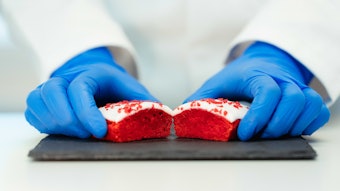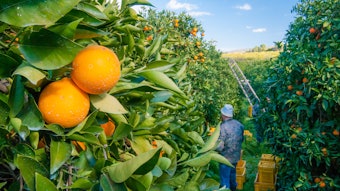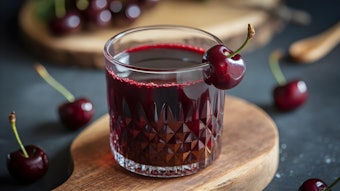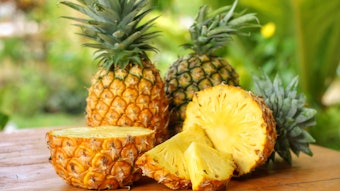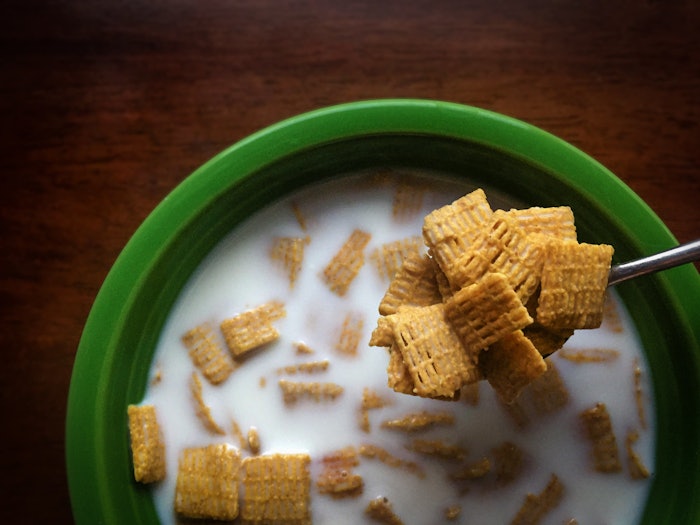
gamma-Octalactone (FEMA# 2796, CAS# 104-50-7) has a very attractive, soft, creamy coconut character and was featured in the November Flavorcon meeting.
Using it in coconut flavors might seem counterintuitive because delta-octalactone, not gamma-octalactone, is the driving force behind coconut aroma in nature. That raises the question—should we really limit ourselves to copying nature? The choice boils down to an entertaining, win-win contest between authenticity and creativity. In any case, even if gamma-octalactone does not feature in coconuts, a quick glance at the VCF online database shows that it is very widely found in nature.
Read this article in page view in the Perfumer & Flavorist+ January 2024 Digital Edition.
Note that the dose rates given throughout this article are the levels suggested for use in flavors intended to be dosed at 0.05% in ready-to-drink beverages or in a simple bouillon.
 gamma-Octalactone adds a soft coconut note that can enhance all meat flavors. Fifty ppm is an initial level in bacon flavors.Pexels image by Polina Tankilevitch
gamma-Octalactone adds a soft coconut note that can enhance all meat flavors. Fifty ppm is an initial level in bacon flavors.Pexels image by Polina Tankilevitch
Savory Flavors
Bacon: gamma-Octalactone adds a soft coconut note that can enhance all meat flavors. Fifty ppm is an initial level in bacon flavors.
Beef, Roast: Rather more, around 100 ppm, is better in beef flavors, enhancing the effect of grilled fat.
Chicken: The best level in chicken flavors varies. Fifty ppm is reasonable, but double that level is better in fried chicken flavors.
Grill: Here is where this ingredient really comes into its own. Now 300 ppm is just a starting point.
Ham: gamma-Octalactone is only a nice finishing touch in ham flavors, but 20 ppm definitely enhances the profile.
Lamb: Lamb has a pronounced fat character and the ideal level of this ingredient, 100 ppm, reflects this.
Mushrooms, Onions and Potatoes: All cooked vegetables benefit from a trace of gamma-octalactone. Levels range from 5 ppm to 15 ppm.
Seafood, Shrimp: gamma-Octalactone enhances all seafood flavors at levels of addition in the region of 50 ppm.
Berry Fruit Flavors
Blackberry: gamma-Octalactone is not the dominant lactone in blackberries, but it rounds out the profile nicely at 80 ppm.
Blackcurrant: Blackcurrant flavors also use this ingredient, but at a lower level around 50 ppm.
Blueberry: Blueberry flavors have an even more subtle lactone note, 20 ppm of gamma-octalactone softens the profile.
Cranberry: The same 20 ppm of gamma-octalactone is equally effective in cranberry flavors.
Raspberry: gamma-Octalactone is very effective when used in combination with delta-octalactone. The balance between the two lactones can be varied but 100 ppm of gamma-octalactone is a good starting point.
Strawberry: In strawberry flavors, this lactone is the junior partner to gamma decalactone, but 100 ppm also works.
Tropical Flavors
Coconut: gamma-Octalactone can be very attractive as the main lactone in coconut flavors. Five thousand ppm is an effective level.
Guava: gamma-Octalactone softens the impact of gamma-decalactone in guava flavors. Levels can vary widely, but 50 ppm is a good starting point.
Jackfruit: Jackfruit flavors can be quite aggressive. One hundred ppm of gamma-Octalactone balances the profile.
Mango: gamma-Octalactone provides a very nice counterpoint to the rather harsh skin character of diphenyl oxide, 1,000 ppm is a good starting point.
Papaya: The ideal level of gamma-octalactone ranges from 10 ppm to 50 ppm.
Passionfruit: Passionfruit flavors can benefit from the creamy softness of this raw material at 100 ppm.
Pineapple: Exactly the same comments and levels also apply to all styles of pineapple flavors.
Orchard Fruit Flavors
Apricot: The attractive partnership between gamma-decalactone and gamma-octalactone reaches its peak in peach and apricot flavors. The level of gamma-octalactone can be varied between 50 ppm and 200 ppm in apricot flavors, depending on the effect desired.
Nectarine: Levels can also vary in nectarine flavors, but 200 ppm is also generally effective in this category.
Peach: It is possible to push things a little further in peach flavors. gamma-octalactone can be used up to 500 ppm.
Plum: Plum flavors encompass a number of different styles. This ingredient will work in all of them but the levels will vary. Twenty ppm is a good starting point.
Alcoholic Drink Flavors
Brandy: The attraction of gamma-octalactone in the spirit flavors is more a question of cost than character. One hundred ppm adds a good impression of cask aging.
Rum, Dark: Two hundred ppm of gamma-octalactone rounds out the character of dark rum flavors.
Tequila: gamma-Octalactone, added at 10 ppm, gives a modest impression of age to tequila flavors.
Whiskey: This is particularly true for whiskey flavors and a relatively high level, up to 500 ppm is an economical alternative to whiskey lactone.
Wine: Modest levels of gamma-octalactone, around 10 ppm, give an impression of cask age to both red and white wine flavors.
 gamma-Octalactone can be very attractive as the main lactone in coconut flavors. Five thousand ppm is an effective level.Pexels image by Tijana Drndarski
gamma-Octalactone can be very attractive as the main lactone in coconut flavors. Five thousand ppm is an effective level.Pexels image by Tijana Drndarski
Other Flavors
Butter, Fresh: The lactone enhances and softens the character of the dominant delta lactones in all dairy flavors. Two hundred ppm works well in butter flavors
Cereal: Five hundred ppm is very effective in cereal flavors. Lower levels can also be useful in pizza dough and bread flavors.
Chocolate, Milk: gamma-Octalactone enhances the creamy character of milk chocolate flavors at 200 ppm.
Cream, Fresh: Cream flavors are another example of this lactone working very well in conjunction with delta decalactone. Four hundred ppm is a good level of addition.
Hazelnut and Praline: This ingredient rounds out all nut flavors but is particularly effective in hazelnut flavors. Eighty ppm is a good starting point. This translates to 30 ppm and up in praline flavors.
Milk: gamma-Octalactone is very effective in both fresh and condensed milk flavors. The levels vary a little but should typically be in the order of 50 ppm to 100 ppm.
Peppermint: Cheap mint oils can be improved by the addition of as little as 10 ppm of gamma-octalactone, pushing the profile away from corn mint and towards peppermint.
Popcorn: Popcorn flavors are enhanced by the extra depth and sweetness of gamma-octalactone at levels of addition in the region of 200 ppm.
Raisin: gamma-Octalactone adds sweet depth and creaminess to the dried notes of raisin flavors at around 50 ppm.
Vanilla: The creamy character of this lactone is especially well suited to French-style vanilla flavors. Two hundred ppm is a good level of addition. It also works in Bourbon bean-style flavors, but the level of addition is much lower, around 10 ppm.
Walnut: After hazelnut, walnut is the nut flavor category where this ingredient works best. Twenty ppm is a reasonable starting level, counteracting the drier aspects of the profile.

